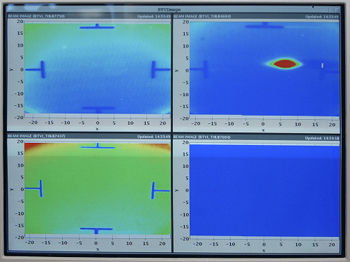Geneva, 17 December 2004. Speaking at the 131st session of CERN1 Council today, the Organization's Director General, Robert Aymar, confirmed that the top priority is to maintain the goal of starting up CERN's Large Hadron Collider (LHC) in 2007.
Geneva, 17 December 2004. Speaking at the 131st session of CERN1 Council today, the Organization's Director General, Robert Aymar, confirmed that the top priority is to maintain the goal of starting up CERN's Large Hadron Collider (LHC) in 2007.
Preparations for the LHC project are advancing well, with half of the most technologically challenging components – the cold masses for the dipole magnets that will steer high-energy protons around the LHC's 27 kilometre ring – having been delivered to CERN. In October the new transfer line that delivers protons from the Super Proton Synchrotron to the LHC tunnel worked at the first attempt. The line is based on 540 magnets supplied by the Budker Institute for Nuclear Physics in Novosibirsk, and has been set up with the help of a team from this Institute.
The discovery in 2004 of defects in components, newly installed, of the system that will distribute cryogenic cooling fluids around the ring meant that installation, begun in 2003, had to be put on hold. However, after intense collaboration between CERN and the company concerned, technical corrections have been made, and in October the manufacture of new unflawed components began. Repair of the faulty components started in November at CERN and the first modified items have been successfully installed in the LHC tunnel.
Various options to make up the delay have been considered, and a strategy of actions has been established to limit the impact on the overall schedule for the LHC. One option that was considered was to shut down the SPS accelerator in 2006 in order to divert human resources to LHC installation. However, this will not be necessary, assuming that technicians can be seconded for a few months from other laboratories working with accelerators to help with LHC commissioning in order to maintain start-up in 2007.
A status report on the four large experiments for the LHC – ATLAS, CMS, LHCb and ALICE – was presented to Council. The report recognised the great progress being made, although the schedules to be ready for collisions in the LHC in 2007 will be tight. However, there is confidence that with some effort the experiments will be ready on time.
The SPS programme reached a natural pause at the end of the 2004 run, with most of its approved experiments reaching their conclusion. The SPS will not run in 2005. "This allows the community to take stock of where they are," said Dr Aymar, "and to plan for an exciting and well-focused programme for future fixed-target physics at CERN." This procedure started in September in the Swiss village of Villars, where the SPS Committee met to set priorities for 2006 and beyond. As a result, Council will be examining proposals for new experiments during the course of 2005.
Elections
Ken J. Peach (GB) was elected as Chairman of the Scientific Policy Committee for a term of one year from 1 January 2005.
Mario Calvetti (IT), Ken J. Peach (GB) and Frank Wilczek (US) were re-elected to the Scientific Policy Committee for a term of three years from 1 January 2005.
Enrique Fernandez (ES), Daniel Fournier (FR) and Donald Harthill (US) were elected to the Scientific Policy Committee for a period of three years from 1 January 2005.
The President of Council and one Vice-President, the Chairman and Vice-Chairman of the Finance Committee, and the Chairman of TREF were re-elected for a period of one year from 1 January 2005.
1. CERN, the European Organization for Nuclear Research, has its headquarters in Geneva. At present, its Member States are Austria, Belgium, Bulgaria, the Czech Republic, Denmark, Finland, France, Germany, Greece, Hungary, Italy, the Netherlands, Norway, Poland, Portugal, the Slovak Republic, Spain, Sweden, Switzerland and the United Kingdom. India, Israel, Japan, the Russian Federation, the United States of America, Turkey, the European Commission and UNESCO have observer status. CERN Council is the body in which the representatives of the 20 Member States of the Organization decide on scientific programmes and financial resources.

